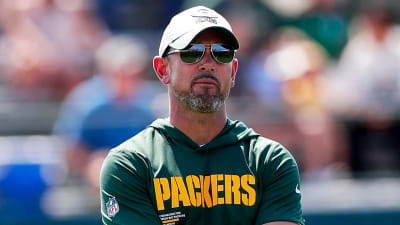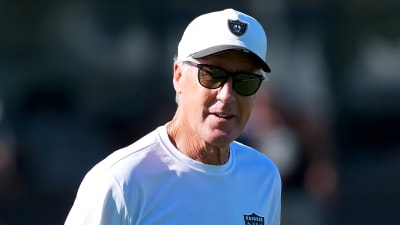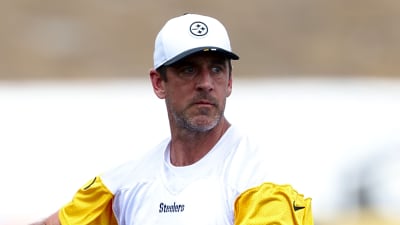
July is the driest month of the year when it comes to NFL news, which makes it the perfect time for something like a top 100 players list. For the fourth straight year, we’re happy to bring you our 2025 NFLTR Top 100 Players.
We’re not the only outlet that does a top 100 — NFL Media has done one with at least some democratic input from current players since 2011 — but our goal is to give more credit to players and positions that are often easy to overlook, especially in the trenches. We build it using traditional and advanced statistics, awards, positional value, career trajectory and a good old-fashioned dash of the eye test. Our list won’t be perfect but the goal is to give as much credit where it’s due as possible.
We’ll be rolling this list out over the next couple of weeks, so keep checking back for updates to our 2025 NFLTR Top 100 Players list.
Resources:
- Pro Football Reference
- QB advanced stats
- Win rates from ESPN for OL and DL
- PFF advanced stats (grades, pass rush productivity, blocking efficiency, coverage stats)
- ESPN WR tracking metrics
- Past NFLTR Top 100s
60 – Jets WR Garrett Wilson
The latest receiver to join the $30 million a year club on a sparkling new contract, Wilson’s first three years have been both a testament to his talent and a missed opportunity. He hit the ground running from Day 1 as a first-round pick and has topped 1,000 yards receiving in all three of his seasons. Wilson has been targeted a staggering 469 times since entering the NFL, third most of any player over the past three years. That says a lot, as targets are earned more than other touches and not just given by default. Based on targets, Wilson is up there with the rest of the NFL’s elite pass catchers.
However, he’s comparatively done a lot less with those looks and it’s not easy parsing out what’s his fault versus the fault of the lackluster offensive environment the Jets have put up the last three years. The addition of QB Aaron Rodgers was supposed to be a big boon for Wilson after battling through the inconsistencies of Zach Wilson and others, and Rodgers raved about Wilson’s talent. But last year the relationship between the two soured as the season progressed, and after the Jets traded for WR Davante Adams midseason, he soon ascended ahead of Wilson in the pecking order for the offense. Wilson’s tendency to freelance on routes seemed to be the source of the conflict, and that was a weakness league evaluators cited in ESPN’s survey of the top 10 receivers.
Wilson had a solid season statistically with career highs in catches (101), yards (1,104) and touchdowns (seven, equalling his output from his first two seasons combined). Some of the advanced metrics reveal what he left on the field, though, as he ranked below the top tiers in open score (31st) and total score (84th) in ESPN’s receiver tracking metrics, and 25th in PFF’s receiving grade. Still, the Jets’ contract to Wilson shows the faith they have that he can take another step forward, and the hope is the reunion with his college QB Justin Fields will lead to good things.
59 – Falcons RB Bijan Robinson
Last year was a renaissance year for the running back position, with big performances from big stars. Even with all-time performances from guys like Saquon Barkley, Derrick Henry, Jahmyr Gibbs and more, Robinson more than held his own in his second season. An outstanding athlete who’s got speed, strength, shiftiness and versatility, Robinson ranked third in the NFL with 1,456 yards rushing, scoring 14 touchdowns on the ground and adding another 61 catches, 431 yards and a score through the air.
Robinson actually led all running backs in success rate, which is defined as gaining at least 40 percent of the yards required on first down, 60 percent on second down and 100 percent on third or fourth down. An impressive 60.2 percent of his carries met those marks. PFF tracked him with a sparkly 70 missed tackles forced on his 304 attempts, too, ranking fourth among all backs last season. With a first-year starter under center in 2025, expect the Falcons to lean even harder on Robinson this coming season.
58 – Rams DE Jared Verse
This is a lofty debut for a player who had just 4.5 sacks in his rookie season. But sacks don’t always tell the whole story in the NFL, and if you look deeper, it’s clear why Verse dominated the voting for Defensive Rookie of the Year. He led the entire NFL with 89 total pressures, per PFF, and was a game-wrecking force. ESPN ranked him 14th among all edge rushers with a pass rush win rate of 18 percent, and while PFF uses a different methodology for its win rate, Verse was similarly outstanding at 19.7 percent and sixth in the league. Verse was a complete player as a rookie too, ranking sixth in the NFL with a run stop win rate of 32 percent, per ESPN, and piling up 41 total stops to rank third among edge rushers, via PFF. He added two forced fumbles, two recoveries and two batted passes.
The most telling indicator of Verse’s potential might be how his peers rave about him, however. Retired Dolphins LT Terron Armstead mentioned Verse specifically as a reason he was ready to call it quits after this past season.
“That young boy Jared Verse? I’m cool,” Armstead said. “I’m good, I never gotta see that man again. I’m OK with never seeing that young man again in my life. Bull rush different — Dawg, it’s different. You know that it’s coming, you brace yourself. He’s different. Jared Verse is different. He will be a defensive player of the year one of these days. Mark my words.”
57 – Seahawks CB Devon Witherspoon
The Seahawks have built a strong reputation for defensive back play in the last couple of decades and Witherspoon arrived in town as one of the franchise’s premier investments given his draft capital as a top-five selection. He’s done a good job of living up to his draft slot in his first two seasons, earning Pro Bowl honors both years.
Like a lot of his Seahawks predecessors, Witherspoon is a tone-setter in the secondary from his nickel position. While the league was hip to Witherspoon in Year 2 and he didn’t stuff the stat sheet as much as his rookie year, he still piled up 98 total tackles, six tackles for loss, a sack, a forced fumble and nine pass deflections. PFF had him leading all cornerbacks in stops, defined as tackles that create a successful play for the defense, with 39. The assignments Witherspoon gets as a slot corner don’t lend themselves to giving up a low completion percentage, however, he improved his yards per catch allowed to 9.1, good enough for 15th-best out of 128 qualifying corners.
56 – Ravens C Tyler Linderbaum
Don’t mistake the Ravens declining Linderbaum’s fifth-year option this past year as some sort of referendum on the player. It was an economic technicality based on the way the NFL handles contract tenders for offensive linemen, lumping them all together rather than splitting out tackles, guards and centers. The tender and tag for Linderbaum would have been significantly higher than the current top of the center market, so expect the two sides to work on a deal more in line with that.
Linderbaum has been a rock since arriving in Baltimore after a first-round draft slide. He’s a little on the small side and that’s exposed occasionally, but he punches above his weight class thanks to his wrestling background. He had the fourth-best pass block win rate of any interior offensive lineman at 97 percent per ESPN, and PFF had him at 98.4 percent in pass pro efficiency each of the last two seasons. The service hasn’t credited him with a sack allowed in two years, either.
55 – Ravens LB Roquan Smith
Smith earned first-team AP All Pro honors for the second straight year and the third time in his career after the 2024 season. His production was remarkably similar to the year before, with 154 total tackles, 1.5 sacks, a forced fumble and an interception. Once again, Smith ranked near the top of the league in stops for linebackers, with 57 per PFF, and was 12th among linebackers in missed tackle rate. Smith also remains well above average in coverage, as he’s been beaten for just one touchdown over the past two seasons.
Beyond all of the stats, which are good, Smith’s biggest impact continues to be on how he lifts his surrounding players. Baltimore once again finished as a top-ten defense despite major turnover on that side of the ball. Smith’s leadership and instincts are harder to measure with stats, but they’re intangible factors that have a major impact regardless.
54 – Jaguars WR Brian Thomas Jr
This is a monster ranking for Thomas after just one season, but the first-rounder had a monster NFL debut. He slid to the 20s in the draft due to being slightly overshadowed by former LSU teammate and Giants first-round WR Malik Nabers (who we’ll also see on this list), and because of questions about how well-rounded his game was. But Thomas showed that sometimes the NFL is a simple game — just be bigger and faster than everyone else. At 6-3 and 209 pounds with long arms, jumping skills and 4.33 speed in the 40-yard dash, Thomas’ elite athleticism immediately translated to the tune of 87 catches for 1,282 yards and 10 touchdowns.
It also helped that Thomas was not just a one-trick pony like some evaluators thought he might be coming out of LSU. He ranked 19th in the league in PFF’s receiving grade, which has a component of measuring how well players create separation independent of whether they’re thrown the ball or not. Thomas was also a respectable 29th in ESPN’s open score, which uses player tracking data to measure separation. His overall score of 46 ranked lower at 43rd but was still above average league-wide. More importantly, it shows there’s still room for growth for a player who already has established a hell of a floor.
53 – Chargers WR Ladd McConkey
McConkey was a stellar find for the Chargers in the early second round as the ninth receiver off the board, going on to not only blow his numbers at Georgia out of the water in his first NFL season but also outproduce nearly every wideout taken in front of him. McConkey’s physical dimensions and coloration spark easy reminders of guys like Wes Welker, Julian Edelman and a host of others in that archetype. He certainly can win with good routes in tight spaces like those players but don’t let appearances and his background get it twisted — McConkey’s not some blue collar try-hard, he ran a 4.39-second 40-yard dash and tested like a high-level NFL athlete.
Combine high-level athleticism with technically proficient skills and a borderline elite starting quarterback like Justin Herbert, and you get the type of special rookie season like what McConkey had. He had a bit of a slow start but eventually found his groove to record 82 catches for 1,149 yards and seven touchdowns — and that does not include a nine-catch, 197-yard performance in the playoffs when he seemed to be the only Chargers receiver with a pulse. The underlying metrics show McConkey was not just the beneficiary of being the apple of Herbert’s eye. His open score of 77 was 14th-best in the league and his total score of 61, PFF receiving grade and 2.96 yards per route run against man coverage all ranked 12th-best. Those would be great numbers for a five-year veteran, let alone a rookie.
If there’s a concern, it’s that McConkey had a notable injury history in college and he did get banged up some in his first season, although he played 17 of 18 possible games. He’s not the biggest receiver at 6-0 and 186 pounds, though he’s well within acceptable NFL thresholds. The Chargers are undoubtedly going to lean on him even more going forward so time will tell if he can hold up.
52 – Falcons WR Drake London
London was the first wide receiver drafted in a 2022 class that included Wilson, Chris Olave, George Pickens, Jameson Williams and a few others. While he’s been held in high regard and has solid production, last year was a true breakout season. He had his first 1,000-yard season and notched 1,271 yards while hoovering up 100 catches and scoring nine touchdowns.
At 6-4 and 213 pounds, London is a huge target, but what sets him apart are his silky movement skills despite his size. A former basketball player who dabbled in college at USC, London knows how to use his frame to his advantage as a route runner and in the red zone. He’s not a plodder — ESPN charted him with an open score of 84 which was the fourth-best mark in the league. His 90.1 PFF receiving grade (sixth) and overall ESPN receiver score of 65 (eighth) were also high-end marks, and his 2.98 yards per route run against man coverage ranked ninth out of 106 qualifying wideouts. The Falcons believe London has arrived as a bona fide No. 1 receiver and the numbers say they’re right.
51 – Commanders LT Laremy Tunsil
Tunsil remains one of the elite pass protectors in football even as he goes into his age-31 season, which is why the Commanders were comfortable trading a package of Day 2 picks for his services this offseason. He was 10th in ESPN’s pass block win rate leaderboard at 93 percent, and PFF charted him with a 96.7 efficiency rating in true pass sets to tie for 10th-best among all qualifying tackles. In overall pass protection efficiency, Tunsil’s 98.1 percent rate was No. 5. He should be an immediate upgrade on the blindside for Commanders QB Jayden Daniels.
That said, there are a few reasons the Texans were willing to move on. Tunsil has always had an issue with penalties and was flagged 19 times last year. He’s a lot closer to average as a run blocker, and he’ll undoubtedly be seeking a new contract soon. All that being said, though, pass protection is an extremely difficult and valuable skill, and Tunsil’s body of work suggests he’s one of the five best in the NFL at it.
More must-reads:
- Colts GM expresses regret on Anthony Richardson decision
- Why critical Cam Ward comments are a good thing for Titans
- The 'NFL stadium names' quiz
Breaking News
Trending News
Customize Your Newsletter
 +
+
Get the latest news and rumors, customized to your favorite sports and teams. Emailed daily. Always free!








